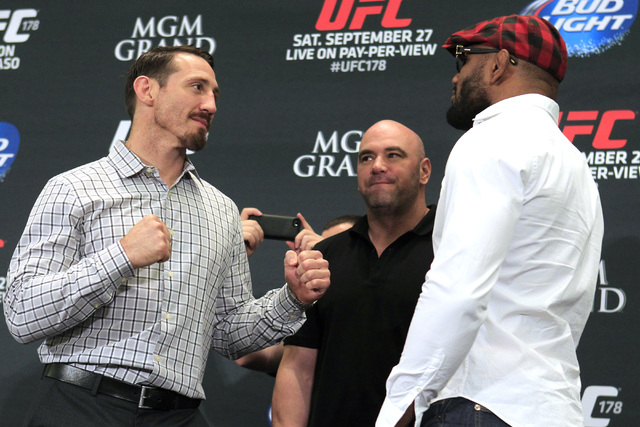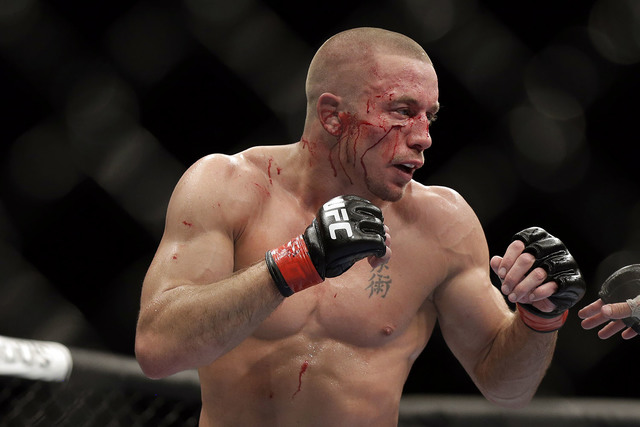Fighters’ association created for mixed martial arts athletes


When Tim Kennedy started fighting in 2001, he never could have imagined professional mixed martial arts would reach its heights of today.
He even recalls rushing to the bank to cash his meager checks out of fear they might bounce.
That’s no longer a concern after his current employer, the Las Vegas-based Ultimate Fighting Championship, was sold in July for a reported $4 billion to Hollywood conglomerate WME-IMG.
“I would have assumed that if the UFC had reached the level they have, it would have been shaped differently,” the 37-year-old Army Ranger said on a conference call Wednesday. “I’d have thought the fighters would not be left behind.
“When we get hurt, when we retire, when we’re damaged, that there would be something there. A safety net. It’s not there.”
Kennedy was joined by four other prominent fighters to announce the formation of the Mixed Martial Arts Athletes Association, the latest of several attempts to organize professional fighters.
“We’re going to change the face of the entire industry and the sport today,” Kennedy said.
The difference between this group and previous incarnations is the inclusion of current star fighters. Former champions Cain Velasquez and TJ Dillashaw also spoke on the call, along with Donald “Cowboy” Cerrone and semiretired superstar Georges St. Pierre.
“I’m one of the rare fighters who came out healthy and wealthy,” St. Pierre said. “I can’t say that about most of the guys. Most sports, the split between promoter and athlete is around 50 percent. For us, it’s about 8 percent.
“Things have to change. The UFC without fighters is only three letters of the alphabet. I think it’s time for us to make our voice heard and make change happen.”
Fighter pay and total revenue long have been guarded industry secrets. UFC officials have insisted the revenue split is higher. Some previous estimates have put the number somewhere around 15 percent.
The five fighters on the call will be the voting members of the MMAAA. Former Bellator MMA CEO Bjorn Rebney will be an adviser to the group, which he stressed will be a trade association and not a union.
Rebney said the group plans to pursue a financial settlement with the UFC over past revenue to benefit past and present fighters, then negotiate deals that will bring the share of fighters’ revenue more in line with the nearly 50/50 split seen in other major sports and finally reach a collective bargaining agreement with the UFC.
“That one-sided system the UFC has in place and the new owners are trying to keep in place will get changed and changed immediately,” Kennedy said.
A UFC spokesperson declined comment on the record, but a senior official said the organization is willing to listen to its fighters.
“We respect all of our athletes and are always open and willing to hear their thoughts on how to improve the sport,” the official said.
Velasquez, a former heavyweight champion who will fight for a likely title shot against former champ Fabricio Werdum on Dec. 30 at T-Mobile Arena, said there are important issues the MMAAA can improve for fighters.
“My first UFC fight was in 2008, and since that time, I’ve had seven surgeries,” Velasquez said. “I have a fight Dec. 30, and after that fight, I’m already scheduled for my next surgery. For us, there is no post-retirement health plan. That’s why I think it’s important for us what we’re doing now to come together.”
Cerrone also mentioned a health plan and a pension as pressing issues. He and Dillashaw expressed concern about potential backlash from the organization from their participation in the association.
“Years ago, if you’d have asked me to speak up, I probably wouldn’t have for fear of being (punished),” Cerrone said. “There’s still fear, but it needs to be done. We’re putting ourselves out there. What’s going to happen? I have no idea. But we’re here.”
St. Pierre, who wants to return to fighting but is embroiled in a contract dispute with the UFC, said he has the benefit of having made enough money to not worry about repercussions.
“Every time we go into a fight, we’re afraid,” he said. “But this is a different kind of fight. It’s time to step up and do the right thing. We should never be afraid to stand for what is virtuous.”
The fight might extend beyond the octagon. All of the fighters except Cerrone are represented by top Hollywood firm Creative Artists Agency, a rival of WME-IMG.
Rebney pointed out that MMAAA was separate from CAA, though he took several shots at WME-IMG.
“CAA is not backing this venture, but let’s be super clear: They are supportive of the athletes because that’s what real agencies are supposed to do,” he said.
Kennedy reiterated the project is only about what is best for the athletes.
“There’s nobody from CAA in this room right now,” he said. “This has nothing to do with anyone else besides the fighters.”
While details were scarce, Rebney said the organization has funding. For now, the association will focus only on athletes who have reached the UFC.
Contact reporter Adam Hill at ahill@reviewjournal.com or 702-277-8028. Follow @adamhilllvrj on Twitter.












